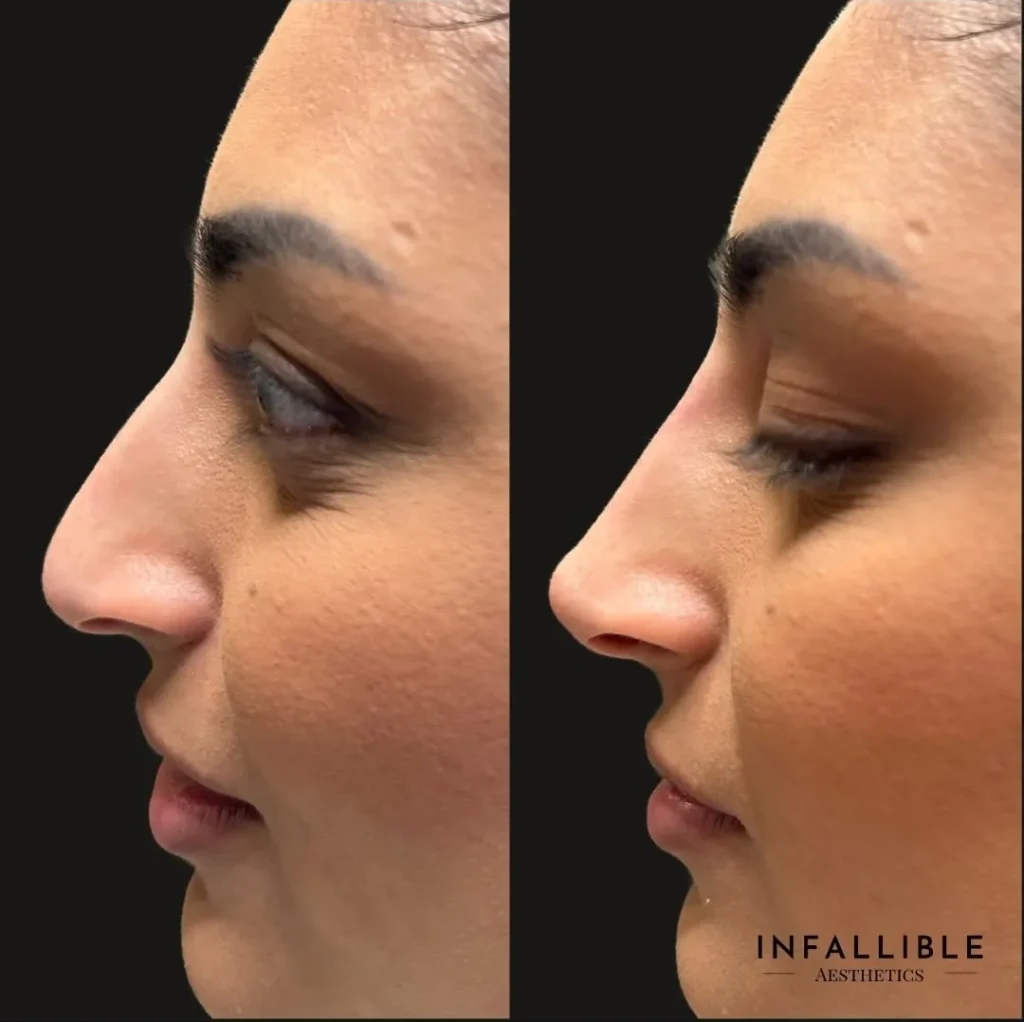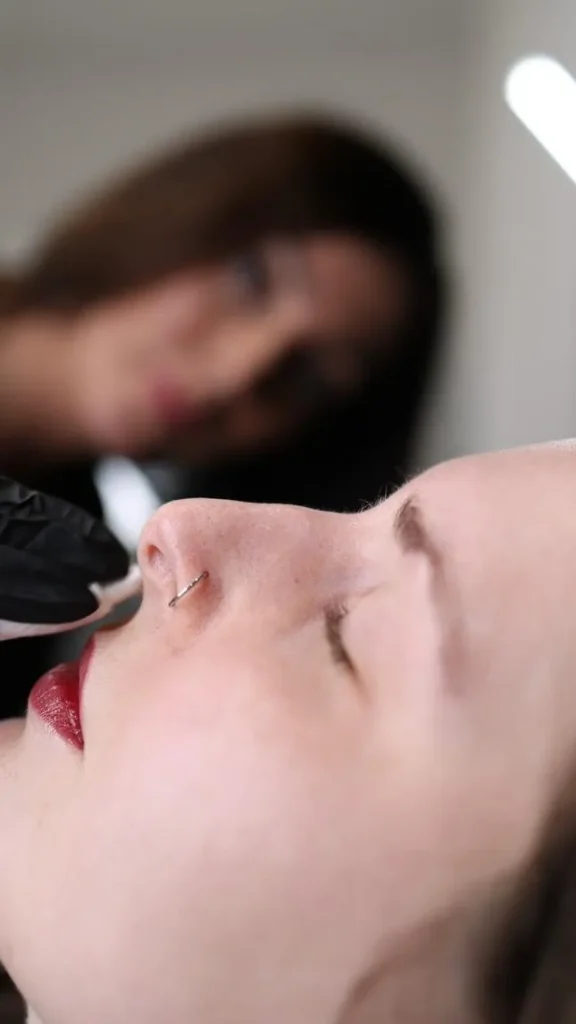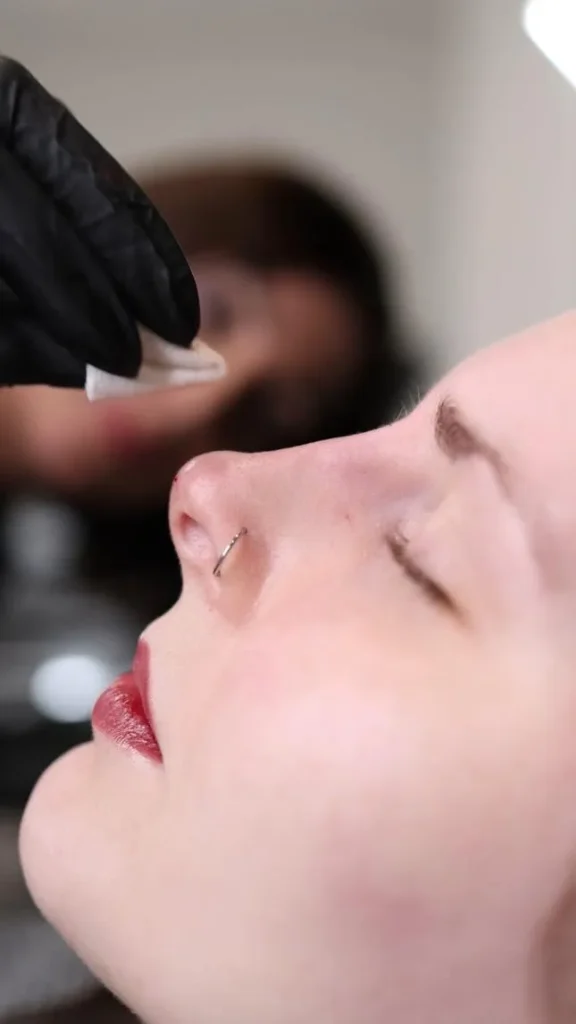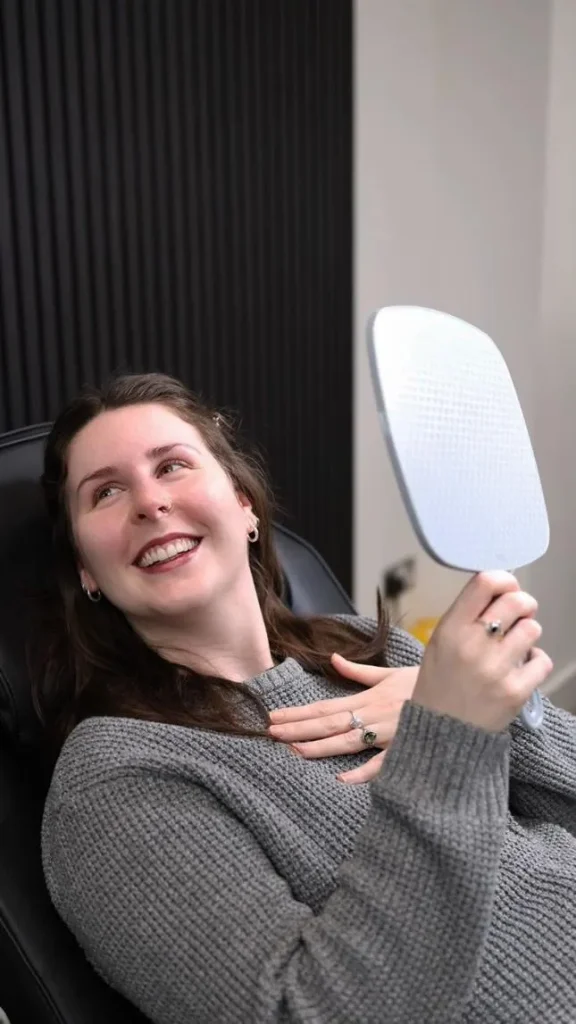Why Non-Surgical Rhinoplasty is So Popular: Key Benefits, Safety, and Patient Appeal
Non-surgical rhinoplasty has surged in popularity by offering dramatic nose contour improvements without incisions or general anaesthesia. By leveraging hyaluronic acid dermal fillers, this non-invasive approach addresses common concerns—such as dorsal hump camouflage and tip refinement—in under an hour with minimal recovery. Readers will discover why immediate results, reduced downtime, cost savings, reversible outcomes, and high satisfaction are driving demand. This guide examines key popularity factors, core benefits of liquid rhinoplasty, comparisons with surgical alternatives, safety considerations, result longevity, patient feedback, and emerging innovations shaping the future of nose reshaping at Infallible Aesthetics in Atherton. Visit us at infallibleaesthetics.co.uk/non-surgical-rhinoplasty/ for more information.
What Makes Non-Surgical Rhinoplasty a Popular Choice?
Non-surgical rhinoplasty is a minimally invasive cosmetic procedure that uses dermal fillers—primarily hyaluronic acid—to sculpt nasal contours by injecting targeted volumes into specific anatomical zones, delivering balance and symmetry without surgery. For example, a subtle filler placement can smooth a modest dorsal hump in minutes.
How Does Non-Invasive Nose Reshaping Offer Immediate Results?
Non-surgical rhinoplasty delivers visible contour improvements immediately after injection, bypassing the weeks of swelling and bruising typical of surgery.
- Patients observe smoother nasal dorsums and lifted tips before leaving the clinic.
- Fine-tuned filler placement corrects asymmetries with instant visual feedback.
- Real-time adjustments allow practitioners to refine results on the spot.
These rapid enhancements set expectations for quick nose refinements without prolonged anticipation.

Why Is Minimal Downtime Important for Patients?
Minimal downtime ensures patients can return to work and social activities almost immediately, making non-surgical rhinoplasty compatible with busy lifestyles.
- Resume normal routines, including light exercise, within 24 hours.
- Avoid visible bandages or sutures, reducing self-consciousness.
- Experience only mild swelling or bruising that subsides within a few days.
Non-Surgical Rhinoplasty Downtime
Non-surgical rhinoplasty has minimal downtime, allowing patients to resume normal activities immediately or within a day or two after the procedure. This contrasts with surgical rhinoplasty, which requires a longer recovery period.
Non-Surgical Rhinoplasty Recovery Time and Benefits – Harley Clinic (2022-05-12)
This supports the article’s claims about minimal downtime associated with non-surgical rhinoplasty.
How Does Reversibility Increase Patient Confidence?
The ability to reverse hyaluronic acid fillers with hyaluronidase empowers patients to adjust or dissolve unwanted results, minimising anxiety about permanent changes.
- Undo overcorrection promptly to restore pre-treatment shape.
- Modify nasal contours over time to reflect evolving preferences.
- Mitigate rare adverse effects, such as vascular compromise, with immediate reversal.
Knowing fillers can be dissolved fosters trust in the procedure’s safety and flexibility at Infallible Aesthetics. Visit us at infallibleaesthetics.co.uk/non-surgical-rhinoplasty/ for more information.
What Are the Cost Advantages Compared to Surgical Rhinoplasty?
Non-surgical rhinoplasty typically requires a fraction of the investment needed for surgery while delivering pleasing aesthetic refinements.
| Procedure Type | Price Range per Session | Typical Recovery |
|---|---|---|
| Non-Surgical Rhinoplasty | £150 – £1,500 | 0–2 days mild downtime |
| Surgical Rhinoplasty | £5,000 – £15,000 | 1–2 weeks moderate downtime |
Choosing liquid rhinoplasty reduces financial commitment and allows patients to “test-drive” nose reshaping before considering permanent surgery.
Liquid Rhinoplasty Cost
The cost of liquid rhinoplasty typically ranges from £600 to £1,500 per session, which is significantly less than the cost of surgical rhinoplasty, which can range from £5,000 to £15,000. The cost depends on factors like the injector’s experience and the type of filler used.
Non-Surgical Nose Job Costs: Factors, Insurance, and Comparisons (2024-05-02)
This supports the article’s claims about the cost advantages of non-surgical rhinoplasty compared to surgical rhinoplasty.
What Are the Main Benefits of Liquid Rhinoplasty?
Liquid rhinoplasty applies dermal fillers in precise anatomical layers to enhance nasal shape, relying on hyaluronic acid’s viscosity and water-binding properties to smooth irregularities. For instance, injecting gel along the nasal bridge can camouflage a small hump, creating a straighter profile.
How Does Liquid Rhinoplasty Provide Subtle and Natural Enhancements?
Liquid rhinoplasty achieves refined results that preserve ethnic features and facial harmony by customising filler volumes and locations.
- Smoothes minor humps without adding bulk.
- Refines nasal tip projection while maintaining natural curvature.
- Balances left-right asymmetries with micro-deposits of filler.
These nuanced modifications support a harmonious appearance rather than an overly operated look.
Why Is the Procedure Time So Short and Convenient?
The non-surgical nose job typically takes between 15 and 60 minutes, including consultation and topical anaesthesia, making it ideal for lunchtime appointments.
- Apply numbing cream and prep within 10 minutes.
- Complete strategic filler injections in 10–30 minutes.
- Provide aftercare guidance in the final 5–10 minutes.
Short appointment durations suit busy schedules and boost patient adherence to follow-up visits.
How Does Non-Surgical Rhinoplasty Boost Patient Confidence?
Immediate aesthetic improvements often translate into psychological benefits, enhancing self-esteem and social comfort.
- Positive self-perception rises as patients notice refined profiles.
- Reduced self-consciousness in photographs or public settings.
- Empowerment from taking control of facial features without surgery.
Improved confidence frequently motivates patients to maintain and build upon their cosmetic journey.



What Are the Advantages of Using Hyaluronic Acid Dermal Fillers?
Hyaluronic acid fillers dominate liquid rhinoplasty due to their biocompatibility, reversibility, and predictable integration into soft tissues.
- Attract and retain water molecules to add volume and smooth contours.
- Biodegradable properties prevent long-term complications.
- Established safety profile with minimal allergy risk.
These attributes position hyaluronic acid as a reliable choice for temporary yet high-quality nose reshaping.
Hyaluronic Acid Fillers Safety
Hyaluronic acid fillers are considered safe and effective for cosmetic use, with minimal risk of allergic reactions due to HA being a natural substance in the body. Common side effects are temporary, and the fillers are reversible with hyaluronidase.
Exploring the Safety and Efficacy of Hyaluronic Acid Dermal Fillers (2024-05-28)
This supports the article’s claims about the safety of hyaluronic acid fillers used in non-surgical rhinoplasty.
How Does Non-Surgical Rhinoplasty Compare to Surgical Rhinoplasty?
Non-surgical rhinoplasty and surgical rhinoplasty both aim to refine nasal structure, but they differ fundamentally in approach, permanence, and recovery.
What Are the Differences in Permanence and Longevity?
Non-surgical rhinoplasty provides temporary results lasting six to eighteen months, whereas surgical rhinoplasty offers permanent structural changes through cartilage and bone reshaping.
- Liquid rhinoplasty uses degradable fillers requiring maintenance.
- Surgical rhinoplasty permanently alters nasal framework.
- Temporary filler options allow incremental adjustments over time.
Understanding permanence guides patients toward the option that best fits their lifestyle and aesthetic goals.
How Do Recovery Times Differ Between Non-Surgical and Surgical Options?
Recovery after non-surgical rhinoplasty involves minimal swelling and bruising for a few days, while surgical rhinoplasty often demands weeks of rest and activity restrictions.
- Non-surgical: gentle compression and icing for 24–48 hours.
- Surgical: nasal casts, splints, and limited exertion for 7–14 days.
Faster recovery from liquid rhinoplasty appeals to those unable to schedule extended downtime.
What Are the Cost Differences Between Both Procedures?
A side-by-side comparison highlights the affordability of liquid rhinoplasty versus the high expense of surgery.
| Aspect | Non-Surgical Rhinoplasty | Surgical Rhinoplasty |
|---|---|---|
| Average Cost | £600 – £1,500 per session | £5,000 – £15,000 total |
| Anaesthesia Fees | None (topical only) | General or IV sedation |
| Facility Charges | Clinic visit | Operating room rental |
Lower costs for non-surgical treatments widen access to cosmetic nose enhancements.
How Do Functional and Aesthetic Goals Influence Procedure Choice?
Patients seeking minor contour refinements without breathing issues often prefer liquid rhinoplasty, while those with functional impairments or major reshaping needs choose surgery.
- Correct minor asymmetries or small humps with fillers.
- Address septal deviations or large structural changes surgically.
- Combine approaches when aesthetic harmony and airway improvement are both desired.
Aligning goals with procedural capabilities ensures optimal outcomes and patient satisfaction.
What Are the Safety Considerations and Risks of Non-Surgical Rhinoplasty?
Safety in non-surgical rhinoplasty centres on practitioner expertise, patient selection, and adherence to aseptic injection techniques. Complications are rare when performed by qualified professionals at Infallible Aesthetics. Visit us at infallibleaesthetics.co.uk/non-surgical-rhinoplasty/ for more information.
How Common Are Complications Like Vascular Occlusion?
Vascular occlusion is an uncommon but serious risk, occurring in less than 0.05% of hyaluronic acid injections when proper technique is followed.
- Prompt recognition of blanching or extreme pain is critical.
- Immediate hyaluronidase injection restores blood flow.
- Training in vascular anatomy reduces incidence dramatically.
Understanding risk frequency and management strategies ensures safer filler applications.
What Role Does Practitioner Expertise Play in Ensuring Safety?
Board-certified physicians with advanced training in facial anatomy minimise adverse events by selecting appropriate injection planes and filler types.
- Precise knowledge of nasal vasculature prevents vessel compromise.
- Real-time assessment adapts technique to individual anatomy.
- Emergency preparedness protocols enable swift complication management.
Expertise remains the most significant factor in safe, effective non-surgical rhinoplasty.
How Is Hyaluronidase Used to Manage Filler Complications?
Hyaluronidase, an enzyme that dissolves hyaluronic acid, serves as an emergency tool to reverse vascular occlusion and correct overfilling.
- Administered around the compromised area to restore perfusion.
- Applied in controlled doses to refine or remove excess filler.
- Acts within minutes, reducing risk of tissue damage.
Hyaluronidase for Filler Complications
Hyaluronidase is an enzyme used to dissolve hyaluronic acid fillers, which is essential for managing complications such as vascular occlusion. It is administered to restore blood flow and correct overfilling.
Hyaluronidase for Dermal Filler Complications: Review of Applications and Dosage Recommendations – PMC – PubMed Central
This supports the article’s claims about the use of hyaluronidase to manage filler complications.
What Are the Typical Side Effects and How Are They Managed?
Mild swelling, bruising, and redness are common and self-limiting after non-surgical rhinoplasty, often resolving within one week.
- Apply cold compresses immediately post-injection.
- Use arnica or bromelain supplements to accelerate bruise resolution.
- Recommend gentle avoidance of saunas and strenuous exercise for 48 hours.
Proactive aftercare guidance mitigates side effects and supports smooth healing.
How Long Do Non-Surgical Rhinoplasty Results Last and What Is Maintenance Like?
Longevity of liquid rhinoplasty results depends on filler composition, injection depth, and individual metabolism, with most patients enjoying improvements for 6–18 months. Seasonal factors and lifestyle can influence product breakdown.
What Factors Affect the Duration of Liquid Rhinoplasty Results?
Several variables determine how long hyaluronic acid fillers remain effective in nasal tissues:
- Filler cross-linking density influences degradation rate.
- Patient metabolism and enzyme activity accelerate or slow breakdown.
- Injection technique and placement depth impact product persistence.
Recognising these factors helps set realistic expectations for result longevity.
How Often Are Repeat Treatments Needed?
Repeat sessions are typically scheduled every 9–12 months to maintain optimal contour and volume.
- Monitor subtle changes in nasal profile during follow-up visits.
- Adjust volumes gradually to refine or enhance previous results.
- Avoid back-to-back high-volume injections that risk tissue overstretching.
Regular maintenance appointments preserve natural-looking enhancements over time.
What Are the Costs Associated with Longevity and Maintenance?
Ongoing investment in non-surgical rhinoplasty reflects session fees and potential volume adjustments based on individual needs.
- Budget for £600–£1,500 per annual session.
- Factor in occasional touch-ups at reduced volumes.
- Compare cumulative costs with a one-time surgical procedure for informed decision-making.
Understanding maintenance expenses empowers patients to plan long-term aesthetic budgets.
What Do Patients Say About Non-Surgical Rhinoplasty?
Patient testimonials and satisfaction data underscore the appeal of liquid rhinoplasty, with high marks for comfort, convenience, and outcome predictability.
How High Are Patient Satisfaction Rates?
Studies report satisfaction rates between 85% and 100% one year post-injection, reflecting consistent approval of nasal contour improvements and procedural experience.
- Over 95% of participants would recommend the treatment to friends.
- High ratings for pain management and minimal downtime.
- Positive feedback on gradual, natural-looking enhancements.
Patient Satisfaction with Non-Surgical Rhinoplasty
Studies show high patient satisfaction rates with non-surgical rhinoplasty using hyaluronic acid fillers, with satisfaction levels ranging from 84.7% to 100% across different studies. The procedure offers immediate results and minimal downtime, contributing to patient satisfaction.
Non-Surgical Rhinoplasty (NSR): A Systematic Review of Its Techniques, Outcomes, and Patient Satisfaction (2023-12-18)
This supports the article’s claims about high patient satisfaction rates with non-surgical rhinoplasty.
What Psychological Benefits Do Patients Experience?
Non-surgical rhinoplasty often yields immediate boosts in self-confidence and social comfort, alleviating concerns over facial harmony.
- Improved self-image in personal and professional settings.
- Reduced anxiety about permanent surgical risks.
- Empowerment from self-directed cosmetic refinement.
These emotional gains complement physical improvements and foster overall well-being.
How Do Before-and-After Results Influence Popularity?
Clear visual evidence of dorsal hump smoothing, tip lifting, and asymmetry correction establishes trust and inspires new candidates to explore non-surgical options.
- Before-and-after galleries showcase realistic outcomes.
- Patient stories highlight individual journeys and result satisfaction.
- Visual proof reinforces claims of minimal swelling and rapid recovery.
Compelling imagery cements liquid rhinoplasty’s reputation for delivering transformative yet natural nose reshaping.
What Are the Emerging Trends and Future Reasons for Growing Popularity?
Innovations in imaging, filler chemistry, and consumer demand continue to expand the appeal of non-surgical rhinoplasty as a leading minimally invasive procedure.
How Are Advanced Techniques Like 3D Imaging Enhancing the Procedure?
Three-dimensional facial scanning enables precise treatment planning by mapping nasal anatomy and predicting filler distribution, improving both safety and aesthetic accuracy.
- Virtual simulations allow patients to preview potential outcomes.
- Custom injection guides optimise filler placement along vascular pathways.
- Data-driven adjustments refine symmetry in real time.
These technological advancements elevate procedural precision and patient confidence.
What New Dermal Filler Formulations Are Driving Interest?
Next-generation hyaluronic acid fillers now feature varying cross-link densities and integrated bioactive compounds to extend longevity and support tissue health.
- Thixotropic gels adapt viscosity under pressure for smoother injections.
- Hybrid formulations combine HA with polynucleotides to promote collagen remodelling.
- Long-chain HA variants resist enzymatic breakdown longer, reducing maintenance frequency.
Innovative filler chemistries promise longer-lasting, more natural results.
How Is Market Growth Reflecting Increased Demand for Minimally Invasive Procedures?
Industry projections indicate a global non-surgical rhinoplasty market expansion from $0.8 billion in 2024 to nearly $1.5 billion by 2030, driven by patient preference for lower-risk, convenient aesthetic treatments.
- Rising acceptance of office-based filler procedures among diverse age groups.
- Greater media visibility of non-surgical enhancements fuelling consumer interest.
- Expanding practitioner training and certification programmes ensuring widespread availability.
Robust market growth underscores non-surgical rhinoplasty’s trajectory as a mainstream cosmetic solution.
Non-surgical rhinoplasty’s blend of instant contour refinement, minimal recovery, reversible outcomes, and cost efficiency has transformed nose reshaping into an accessible in-office experience. As dermal filler technologies and imaging tools advance, this popular procedure will continue to evolve, delivering personalised nasal refinements that align with each patient’s unique aesthetic vision at Infallible Aesthetics. Visit us at www.infallibleaesthetics.co.uk/non-surgical-rhinoplasty/ for more information.
Governing Bodies and Professional Standards
Ensuring the safety and efficacy of non-surgical cosmetic procedures like rhinoplasty is paramount. Several governing bodies and professional organizations set standards and provide guidelines for practitioners. Understanding these entities can help patients make informed decisions about their care.
Regulatory Authorities
In the UK, the Medicines and Healthcare products Regulatory Agency (MHRA) is responsible for regulating medicines and medical devices, including the dermal fillers used in non-surgical rhinoplasty. They ensure that products meet safety and quality standards before they can be marketed and used.
For surgical procedures, the Care Quality Commission (CQC) inspects and rates health and social care services in England, including cosmetic surgery clinics, to ensure they provide safe, effective, and high-quality care.
Professional Medical Bodies
Professional organizations play a crucial role in setting clinical standards, providing training, and promoting best practices among medical professionals. For practitioners performing non-surgical rhinoplasty, relevant bodies include:
- The Royal College of Surgeons, which sets standards for surgical training and practice.
- The British Association of Cosmetic Nurses (BACN), which supports nurses in aesthetic practice.
- The British Society for Restorative Medicine (BSRM), which focuses on non-surgical aesthetic treatments.
These organisations often provide resources for patients seeking information about qualified practitioners and safe treatment options.
Published by Infallible Aesthetics. Proofed by Laura Jones.
